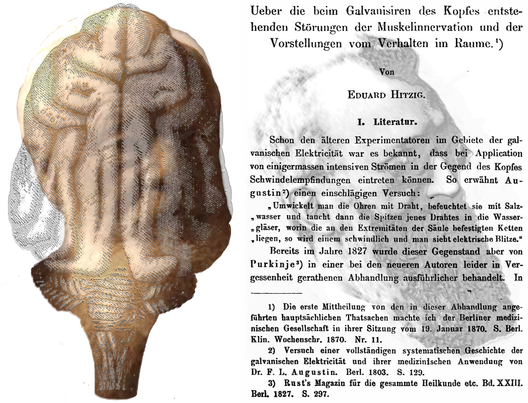Gustav Fritsch(1838–1927) & Eduard Hitzig(1838–1907)
The senses had been excited electrically but it was believed that brain itself would not respond to such stimulation. Indeed, Hitzig is shown on the right in an article in which he applied currents to various places on the head and noted the consequences. In 1871 he examined eye and head movements during galvanic stimulation of the ears and likened nystagmus so produced to a fisherman’s float drifting slowly downstream and then being snatched back. One year earlier, together with Fritsch, he had stimulated the exposed brain of unanaesthetized dogs electrically, and the results were dramatic. The long-held view that the brain was unaffected by direct stimulation was overturned. They found specific precentral areas that resulted in muscular contractions and they divided the cortex into two parts - motor and not motor. Thus a new physiology, based on cortical localization, was being established. Hitzig held an academic position in Berlin, but it was not possible to carry out the experiments in his institution, so they were conducted in Fritsch’s house. The article (On the electrical excitability of the cerebrum) describing the experiment was published in 1870 and its impact was immediate. They concluded their report thus: “ There can hardly be a question about an opinion which seems so completely settled as that of the excitability of the cerebral hemisphere”. Hitzig was a neurologist who later held posts in psychiatry in Zurich and Halle where he continued his research on cortical localization. Fritsch, who is shown on the left within the diagram of a dog’s brain, remained in Berlin and became more interested in histology and ethnology.
